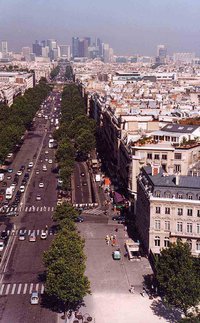Baron Haussmann
|
|
Georges-Eugène, Baron Haussmann (March 27, 1809 – January 11, 1891) was a French civic planner whose name is associated with the rebuilding of Paris. He was born in that city of a Protestant family, German in origin.

He was educated at the College Henri IV, and subsequently studied law, attending simultaneously the classes at the Paris conservatoire of music, for he was a good musician. He became sous-préfet of Nérac in 1830, and advanced rapidly in the civil service until in 1853 he was chosen by Persigny prefect of the Seine département in succession to Jean Jacques Berger, who hesitated to incur the vast expenses of the imperial schemes for the embellishment of Paris. Haussmann would remain in this post until 1870.
Commissioned by Napoleon III to instigate a program of planning reforms in Paris, Haussmann laid out the Bois de Boulogne, and made extensive improvements in the smaller parks. The gardens of the Luxembourg Palace (Luxembourg Garden) were cut down to allow of the formation of new streets, and the Boulevard de Sebastopol, the southern half of which is now the Boulevard St Michel, was driven through a populous district. Additional, sweeping changes made wide "boulevards" of hitherto narrow streets. A new water supply, a gigantic system of sewers, new bridges, the opera, and other public buildings, the inclusion of outlying districts - these were among the new prefect's achievements, accomplished by the aid of a bold handling of the public funds which called forth Jules Ferry's indictment, Les Comptes fantastiques de Haussmann, in 1867. (A play on words between contes, stories or tales - as in Les Contes d'Hoffmann or Tales of Hoffmann, and comptes, accounts.)
A loan of 250 million francs was sanctioned for the city of Paris in 1865, and another of 260 million in 1869. These sums represented only part of his financial schemes, which led to his dismissal by the government of Émile Ollivier. After the fall of the Empire he spent about a year abroad, but he re-entered public life in 1877, when he became Bonapartist deputy for Ajaccio.
His work had destroyed much of the medieval city. It is estimated that he transformed 60% of Paris' buildings. Notably, he redesigned the Place de l'Etoile, and created long avenues giving perspectives on monuments such as the Arc de Triomphe and the Opera Garnier.
Haussmann had been made senator in 1857, member of the Academy of Fine Arts in 1867, and grand cross of the Legion of Honour in 1862. He died in Paris and is buried in Le Cimetière Père Lachaise, Paris. His name is preserved in the Boulevard Haussmann. His later years were occupied with the preparation of his Mémoires (3 vols., 1890-1893).
| Contents |
Haussmann's plan for Paris
‘Between the Revolution of 1789 and Haussmann's renovation in the 1860's, ideals changed from those of a politically motivated city to those of an economically and socially centered city. Modern technology such as railroads and gas lamps were conveniences which the rising bourgeoisie could enjoy in their leisurely lifestyle. New spaces that were created during the renovation encouraged the bourgeoisie to flaunt their new wealth, creating a booming economy. All of these examples of the changes occurring in Paris during this time period can be seen in representations of the city.’ ‘There are two views of Baron Haussmann: One depicts him as the man who destroyed Old Paris, and the other as the man who created New Paris.’
Baron Georges Eugene Haussmann (1809-1892) was hired by Napoleon III on June 22, 1853 to "modernize" Paris. He hoped in hiring Haussmann that Paris could be moulded into a city with safer streets, better housing, more sanitary, hospitable, shopper friendly communities, better traffic flow, and streets too broad for rebels to build barricades across them. Haussmann accomplished much this by tearing up many of the old, twisting streets and rundown apartment houses, and replacing them with the wide, tree-lined boulevards and expansive gardens which Paris is famous for today.
Haussmann the Hero
"How ugly Paris seems after a year's absence. How one chokes in these dark, narrow and dank corridors that we like to call the streets of Paris! One would think that one was in a subterranean city, that's how heavy is the atmosphere, how profound is the darkness!" -the Vicomte de Launay, 1838,(as quoted in Rice, p 9) Historian Shelley Rice, in her book "Parisian Views" says that "most Parisians during [the first half of the nineteenth century] perceived [the streets] as dirty, crowded, and unhealthy . . . Covered with mud and makeshift shanties, damp and fetid, filled with the signs of poverty as well as the signs of garbage and waste left there by the inadequate and faulty sewer system . . ."" (p 9). For these people, Haussmann was performing a much needed service to the city and to France.
Haussmann the Destroyer of Paris
Because of Haussmannization, the 1860's was a time of intense revolt in Paris. Many of the people of Paris were troubled by the destruction of ‘old roots’. Historian Robert Herbert says that ‘the impressionist movement depicted this loss of connection in such paintings as Manet's "Bar at Folies," 1882. The subject of the painting is talking to a man, seen in the mirror behind her, but seems unengaged. According to Herbert, this is a symptom of living in Paris at this time: the citizens became detached from one another The continuous destruction of physical Paris led to a destruction of social Paris as well’. Haussmann was also blamed for the great cost of his project. Napoléon III fired Haussmann on January 5, 1870, in order to increase his approval ratings.
See also
References
- Parts of this entry were originally from the 1911 Encyclopædia Britannica.
External links
- Georges Eugène Haussmann (http://www.insecula.com/contact/A008343.html/)de:Georges-Eugène Baron Haussmann
es:Barón Haussmann fr:Baron Haussmann nl:Georges-Eugène Haussmann pl:Georges Haussmann ro:Baronul Haussmann
